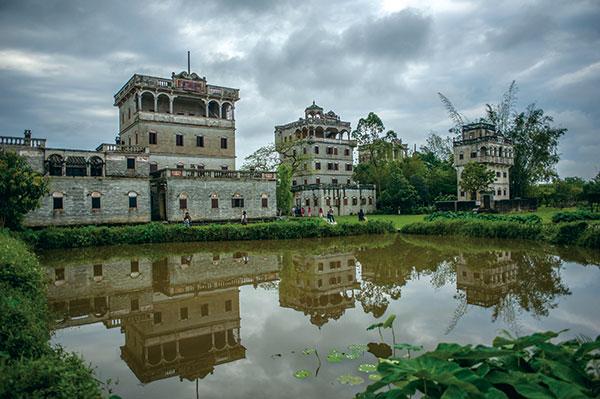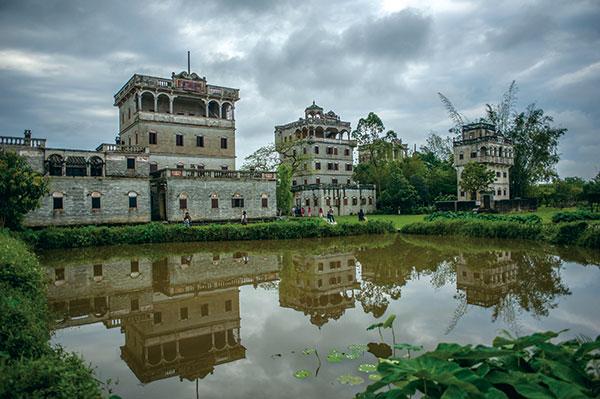he Kaiping Diaolou make up one of China’s more unusual sites. Almost 2,000 of these diaolou (watchtowers) are scattered across the lush countryside around Kaiping City and the Taishan area of Guangdong Province, not far from Guangzhou and Hong Kong. The general template is a fantastical palace sitting atop a much plainer tower serving as a sort of pedestal. Their unexpected fusion of Western and Chinese architecture was achieved by extensive use of concrete and in 2007 a selection of them were added to UNESCO’s list of World Heritage Sites.
The region has a long history of watchtowers. Increasing banditry in the 16th century led villagers to begin putting up defensive structures. Later that century people from the area began trading ever further from the south coast, into southeast Asia. In the mid 1800s increasing tensions at home and the lure of making money abroad led to mass emigration. Thousands left China for the US, Australia, Canada and southeast Asian nations such as Malaysia and the Philippines. Although they mainly worked in manual labour – in the gold mines, building railways – families nonetheless began to amass wealth.
Money was sent back home from the emigres. New houses were built. This ostentation attracted banditry again, calling for more defensive buildings. However, unlike the simpler structures from the 16th century, this time they were done with panache. The emigres hadn’t felt accepted by the societies they’d moved to and instead went about making a name for themselves in their homeland.
To demonstrate their newly acquired worldly esthetics while still being practical, they built their towers with “red hair mud.” This was the name for concrete, as it was brought by the British who in the 1800s apparently all had red hair – at least compared to Chinese. Its versatility allowed for all manner of styles and structures from doric arches to rooftop balustrades. The structures started going up from the late 19th century, with most being built in the 1920s-30s.
Many of the diaolou in the designated tourist areas are open, with equally surprising interiors. Some are more defensive, with arrow loop-type windows, but most feel very much like homes. Many of the furnishings are still in place, some rooms heaped with bric a brac. They are tiled and have large, open grilles in the floors of upper stories to allow air to circulate. Decoration veers towards the ornate, the likes of which would not be seen again in China until the Louis XIV mania of the mid-2000s.
Kitchens and simple bathrooms can be found on each floor as each level was occupied by a different family within the larger clan. Every house has its own temple, often on the roof terrace, blending ancestor worship and Buddhism. Some have Western-style studies; one even has a freestanding bathtub.
Details are still in place, at least while visitor numbers remain low. Family photos hang in the reception rooms. An elderly lady in Zili Village who surreptitiously gave us a look around the tower she lives in (what’s another 5 yuan on top of the 180 yuan entry?) showed us furniture made from the timber the family she married into had gotten rich from. She now lives just in the reception room, unable to manage the stairs to the five floors above. Overseas remittances are still the main source of income for most villages.
Roaming from cluster to cluster, you’re likely to pass through the town of Chikan, itself something of a tourist site. It’s a good place to stop for lunch and our driver showed us how to pour tea into our claypot rice to make sure we could swill down every last grain. The smartly fronted qilou shophouses with their covered walkways, built by the Guan and Situ clans, are in remarkable condition. Far more ornate than those found in the rest of southern China and anywhere else in southeast Asia. This sense of grandeur is ramped up to a whole new level at the Movie and Television City. It’s worth seeing for the displays of sets from films such as The Grandmaster.
Hedong Village shows scars of the Cultural Revolution of the 1960s and 70s with slogans calling for patriotism. Given that the movement aimed to purge traditional, capitalist and bourgeois aspects of society, the watchtowers did well to survive with their bourgeois blend of traditional and capitalist prowess.
The towers in general are in various states of conservation and all have escaped the full force of Chinese restoration. Money is being spent on repair, but it’s clear that it’s going to the more spectacular clusters with the lesser or lonely towers quietly decaying. Many stand empty, slowly being swallowed by vegetation. The most stunning of all the towers, the Ruishilou in Jinjiangli, was being repaired, with even the tools being stored in a new little shed built in the style of the rest of the village.
The World Heritage summary of the reasons for inscribing the towers may seem complete: “The diaolou and their surrounding villages demonstrate Outstanding Universal Value for their complex and confident fusion between Chinese and western architectural styles, for their final flowering of local tower building traditions, for their completeness and unaltered state resulting from their short life span as fortified dwellings and their comparative abandonment and for harmonious relationship with their agricultural landscape.” Yet they have not caught the imagination of the local tourism market.
The World Heritage listing has brought some attention, but their national status as a mere AAAA level site could be part of the reason for the lack of crowds. Domestic tourism is booming, but still very much a luxury. If you’re joining the ranks of sightseers, you’re going to head to the big hitting AAAAA sites such as the Great Wall and Forbidden City. If you’ve got those under your belt, you’re probably going to be heading overseas.
The Chinese tour buses have yet to roll into town. The vast car parks have many more weeds than vehicles. There are themed trash cans and new signage everywhere and fancy new boardwalks through the marshes. So visit now as you might only have to share a village with a water buffalo.

 Old Version
Old Version


